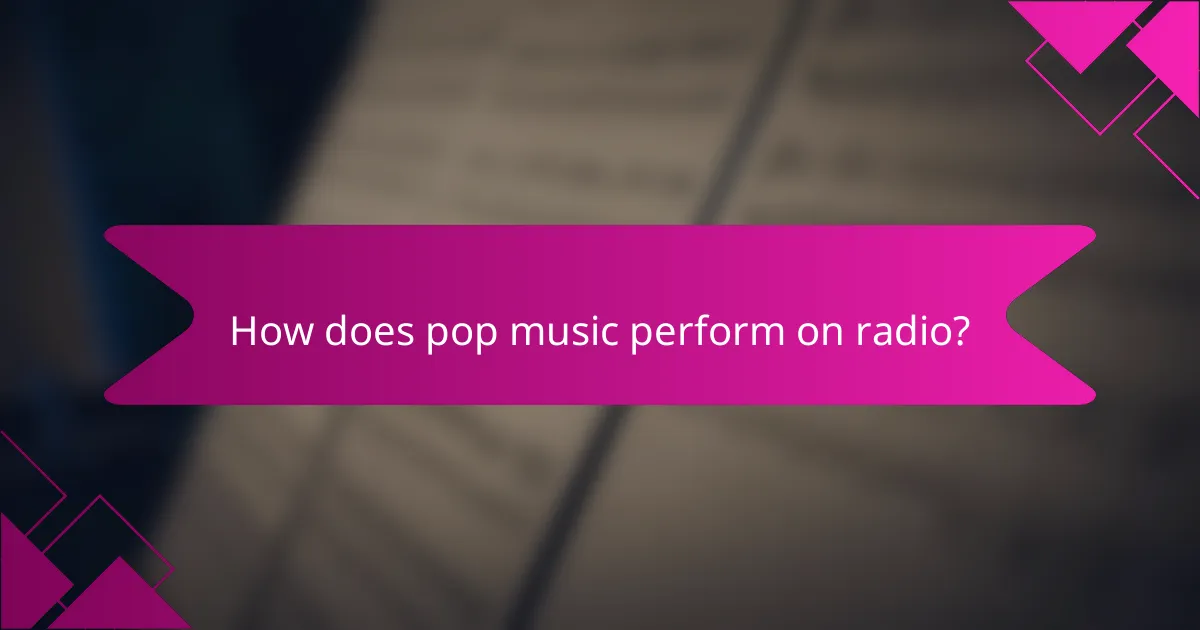Pop music thrives on its mainstream appeal, characterized by catchy hooks and radio-friendly production that captivates a wide audience. By focusing on memorable melodies and relatable lyrics, artists create songs that resonate deeply with listeners, ensuring their tracks remain staples in popular culture. Influential figures like Taylor Swift, Dua Lipa, and Ed Sheeran have shaped the genre, pushing the boundaries of creativity while maintaining broad accessibility.

How to create catchy pop music hooks?
Creating catchy pop music hooks involves crafting memorable melodies and relatable lyrics that resonate with listeners. Focus on simplicity and repetition to ensure your hooks are easily remembered and radio-friendly.
Use memorable melodies
Memorable melodies are the backbone of catchy pop hooks. Aim for simple, singable tunes that can be easily hummed or whistled. Consider using a limited range of notes, typically spanning an octave or less, to enhance memorability.
Experiment with different rhythmic patterns to make your melody stand out. A catchy hook often features unexpected twists or syncopation that grabs attention and keeps listeners engaged.
Incorporate relatable lyrics
Relatable lyrics help listeners connect emotionally with your song. Focus on universal themes such as love, heartbreak, or celebration that resonate across diverse audiences. Use everyday language and imagery to make your lyrics accessible.
Consider incorporating personal anecdotes or common experiences that listeners can identify with. This connection can make your hook more impactful and memorable.
Utilize repetition effectively
Repetition is a powerful tool in pop music, reinforcing the hook and making it stick in the listener’s mind. Repeat key phrases or melodies throughout the song, especially in the chorus, to create familiarity.
However, balance is essential. Overusing repetition can lead to monotony, so vary the arrangement slightly each time to maintain interest while still emphasizing the hook.
Experiment with chord progressions
Chord progressions set the emotional tone of your song and can enhance the catchiness of your hook. Common progressions like I-V-vi-IV are popular in pop music for their uplifting feel. Experiment with variations to find a sound that complements your melody.
Consider using unexpected chord changes or modulations to surprise listeners and keep them engaged. This can create a dynamic contrast that makes your hook more memorable.
Analyze successful pop songs
Studying successful pop songs can provide valuable insights into effective hook creation. Analyze the structure, melody, and lyrics of chart-topping hits to identify common elements that contribute to their appeal.
Take note of how these songs balance melody, lyrics, and instrumentation. Create a checklist of features that resonate with you, and apply those lessons to your own songwriting process.

What are the characteristics of mainstream pop music?
Mainstream pop music is characterized by its broad appeal, catchy melodies, and radio-friendly production. It often incorporates elements that resonate with a wide audience, making it a staple in popular culture.
Appeal to a wide audience
Mainstream pop music is designed to attract listeners from various demographics, including different ages and backgrounds. This broad appeal is achieved through relatable lyrics and universal themes, such as love, friendship, and personal struggles.
Artists often collaborate with songwriters and producers who understand current market trends, ensuring the music resonates with listeners. This strategy helps songs become hits across various platforms, including radio, streaming services, and social media.
Simple song structures
Most mainstream pop songs follow a straightforward structure, typically featuring verses, a chorus, and sometimes a bridge. This simplicity allows listeners to easily remember and sing along, which is crucial for radio play and streaming success.
Common structures include the verse-chorus-verse format, where the chorus serves as a catchy hook that reinforces the song’s main message. This predictability can enhance listener enjoyment and increase replay value.
High production quality
High production quality is a hallmark of mainstream pop music, often involving professional sound engineering and mixing. This attention to detail ensures that the final product is polished and radio-ready, appealing to both casual listeners and audiophiles.
Producers frequently use advanced technology and techniques, such as auto-tuning and layering, to create a rich sound. This level of production can elevate a song’s appeal, making it more competitive in the crowded music market.
Incorporation of current trends
Mainstream pop music often reflects current cultural and musical trends, incorporating popular genres like hip-hop, electronic, and R&B. This blending of styles helps keep the music fresh and relevant to listeners.
Artists and producers stay attuned to emerging trends through social media and music charts, allowing them to adapt their sound quickly. This responsiveness not only enhances the song’s appeal but also increases its chances of becoming a hit.

Which artists define the modern pop landscape?
The modern pop landscape is largely shaped by artists who excel in crafting catchy hooks and radio-friendly tracks. Key figures like Taylor Swift, Dua Lipa, Ed Sheeran, and Ariana Grande have not only dominated charts but also influenced the genre’s evolution through their innovative styles and widespread appeal.
Taylor Swift
Taylor Swift is a defining artist in contemporary pop, known for her storytelling and emotional depth. Her ability to blend country roots with pop sensibilities has allowed her to reach a diverse audience, resulting in numerous chart-topping hits.
Swift’s albums often feature relatable themes and catchy melodies, making them radio staples. Her transition from country to pop with albums like “1989” marked a significant moment in her career, showcasing her versatility and broadening her fan base.
Dua Lipa
Dua Lipa has emerged as a powerhouse in pop music, recognized for her distinctive voice and danceable tracks. Her debut album, “Dua Lipa,” and the follow-up, “Future Nostalgia,” feature infectious hooks and modern production that resonate with listeners globally.
Her singles often incorporate elements of disco and electronic music, appealing to a wide demographic. Songs like “Don’t Start Now” and “Levitating” exemplify her knack for creating radio-friendly anthems that dominate playlists.
Ed Sheeran
Ed Sheeran is celebrated for his melodic songwriting and acoustic influences, making him a staple in the pop genre. His ability to craft heartfelt ballads and upbeat tracks has garnered him massive commercial success, with hits like “Shape of You” and “Perfect” reaching audiences worldwide.
Sheeran’s unique approach often combines elements of folk, pop, and R&B, allowing him to connect with various listeners. His collaborations with other artists further enhance his appeal, making his music a regular feature on radio stations.
Ariana Grande
Ariana Grande is known for her impressive vocal range and catchy pop hooks. Her music often blends R&B influences with mainstream pop, resulting in chart-topping hits like “Thank U, Next” and “7 Rings,” which showcase her versatility and appeal.
Grande’s ability to convey emotion through her lyrics and powerful performances has solidified her status in the pop landscape. Her songs frequently explore themes of love and empowerment, resonating with a broad audience and ensuring her music remains relevant on radio playlists.

How does pop music perform on radio?
Pop music typically dominates radio airplay due to its mainstream appeal, catchy hooks, and radio-friendly production. Stations prioritize songs that resonate with a broad audience, ensuring high rotation for tracks that capture listener interest.
High rotation playlists
High rotation playlists are crucial for pop music’s success on radio. These playlists feature songs that are played frequently throughout the day, often multiple times per hour. This strategy keeps popular tracks at the forefront of listeners’ minds and encourages repeated engagement.
Stations may rotate songs based on listener feedback, streaming data, and chart performance. For instance, a song that gains traction on social media or streaming platforms can quickly find its way into high rotation, boosting its visibility and potential for commercial success.
Chart-topping singles
Chart-topping singles are often the result of extensive radio play, as airplay significantly influences a song’s position on music charts. In the U.S., the Billboard Hot 100 reflects the most popular songs based on radio play, sales, and streaming. Pop songs that achieve high chart rankings typically benefit from heavy rotation on various radio stations.
Successful singles often feature memorable choruses and relatable themes, making them appealing to a wide audience. For example, tracks that blend catchy melodies with universal lyrics tend to perform well, leading to increased airplay and chart success.
Influence on listener demographics
Pop music’s presence on radio significantly shapes listener demographics, attracting a diverse audience across age groups and backgrounds. Stations often curate their playlists to appeal to specific demographics, which can influence the types of pop music that gain traction.
Younger listeners, for instance, may gravitate towards upbeat, danceable tracks, while older demographics might prefer nostalgic hits. Understanding these trends helps radio stations tailor their programming to maximize listener engagement and advertising revenue.

What are the best platforms for distributing pop music?
The best platforms for distributing pop music include Spotify, Apple Music, and YouTube, each offering unique advantages for reaching audiences. Choosing the right platform depends on your target demographic, marketing strategy, and desired engagement levels.
Spotify
Spotify is one of the leading music streaming services, known for its extensive library and user-friendly interface. It allows artists to upload their music through distributors, making it accessible to millions of listeners worldwide.
To maximize your reach on Spotify, consider creating engaging playlists and utilizing Spotify for Artists to track your performance and audience insights. Regularly updating your music and engaging with fans can enhance your visibility on the platform.
Apple Music
Apple Music offers a robust platform for pop music distribution, boasting a large subscriber base and exclusive content opportunities. Artists can distribute their music directly through Apple Music for Artists, which provides analytics and promotional tools.
When using Apple Music, focus on leveraging its curated playlists and radio shows to gain exposure. Collaborating with other artists or influencers can also help you tap into new audiences and enhance your presence on the platform.
YouTube
YouTube serves as a powerful platform for distributing pop music, combining audio with visual elements to engage audiences. Artists can upload music videos, lyric videos, or even behind-the-scenes content to connect with fans.
To succeed on YouTube, optimize your video titles and descriptions with relevant keywords, and promote your content across social media. Engaging with viewers through comments and live streams can also foster a loyal fan base and increase your channel’s visibility.
